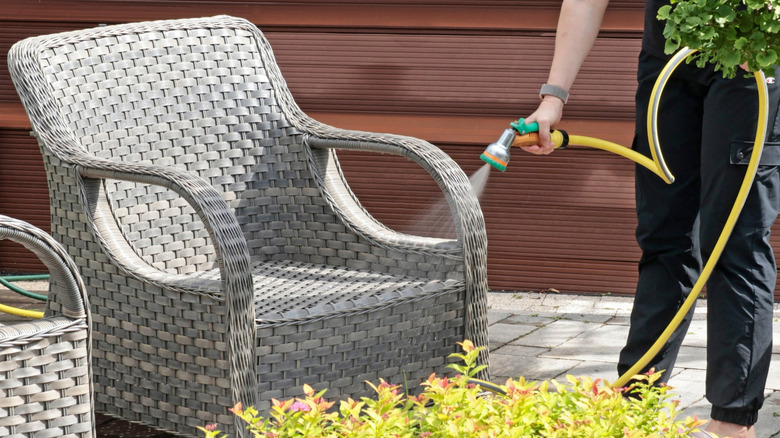The Hack You Need For Refinishing Wicker Furniture (Without Removing Paint)
We may receive a commission on purchases made from links.
So it happened. You went into your favorite thrift store and found a complete four-chair set of wicker furniture plus a matching table for a song — a half a song, really. The problem is that the wicker set boasts a coat of white paint, and you'd really like the set to be just plain khaki-colored wicker. You could sand it 'til next Tuesday, but that would be tedious and probably wouldn't completely get rid of all that white paint in the wicker's nooks and crannies. As it turns out, the thing that gave the set its ghostly-white hue in the first place — spray paint — is also the thing that you should turn to when you'd like to make it all brown and natural-looking again.
Painting is a good way to transform your old wicker furniture, or even just restore it to its original shade. Here's why. The problem with most refurb jobs is that it's really difficult to get into all the nooks and crannies that come with wicker. By giving the set a couple of coats of Rust-Oleum Camouflage 2X Ultra Cover Matte Khaki Spray Paint, you restore the wicker pieces back to their original, unpainted brownish hue without having to actually unpaint them, so to speak.
To do this, you'll need no sandpaper and elbow grease. You'll replace those with the spray paint. This DIY tool will set you back about $5 to $7. Aside from the paint, you'll need a drop cloth to protect the ground, a painter's mask, and possibly some paint brushes if you have custom work in mind.
Prepping the wicker to paint
The challenge with covering pieces like your thrift store find is that they often have spots where the paint has already rubbed or chipped off, which exposes the untreated wicker underneath. To do this project, you'll have to deal with the downsides to wicker furniture. Due to its fibrous nature, it tends to be porous. In light of that, you'll want to make sure that you've taken the proper steps to prep the pieces before you paint them.
A few new coats of spray paint will take care of the porousness. However, you shouldn't paint the pieces without giving them a good scrub first to remove any grit or grime that has settled between the cracks. Sometimes, a good vacuuming will be enough. In these cases, make sure you use a vacuum head with a brush to ensure that you reach into all of the crevices.
When it comes to washing your piece, you'll need some simple tools: a bucket of water and some liquid soap, a stiff-bristle brush, and a few sponges. You can also use a bit of ammonia to guarantee extra cleanliness. This addition may be a good idea if you suspect that the furniture spent some time outdoors and has mold or mildew as a result. You might also need a hose with a sprayer on it to rinse the soapy furniture off once you're done cleaning it off. Be sure to get every nook and cranny by turning the pieces upside down if you have to. Once your wash job is done, the freshly-swabbed wicker needs at least 24 hours to dry before you paint it.
Painting your wicker
Whether you'd like to restore the wicker to a more natural color or upgrade it with some pastel colors to match your shabby chic decor, the steps are basically the same and pretty straightforward. You'll get adequate coverage if you paint the pieces with a paint brush. This method of painting is an option if you'd like to customize the wicker in some way, like if you'd like to add stripes or geometric shapes. In those cases, it's easier to get the job done with a brush than to try to work with spray paint. However, for most jobs, spray paint is your better bet because it can get into all of the small crevices in the wicker.
If you're not working with a spray paint and primer combo, you'll want to prime it before painting to toughen the material up and ensure everything sticks. Be sure to prep your work area by laying down your canvas drop cloth or plastic tarp before you start working. This is especially helpful if you're using a spray-on primer, as it will give the ground you a wide swath of protection.
Once that's done, you'll spray the wicker with a couple of coats of spray paint, keeping the can of paint at least a foot or so away from the object you're refinishing. It'll take a couple of coats of paint to cover the piece completely. It should be dry to the touch within an hour. However, wait four or five hours, or better yet, overnight, before you sit on it or use it to display your knick-knacks.


